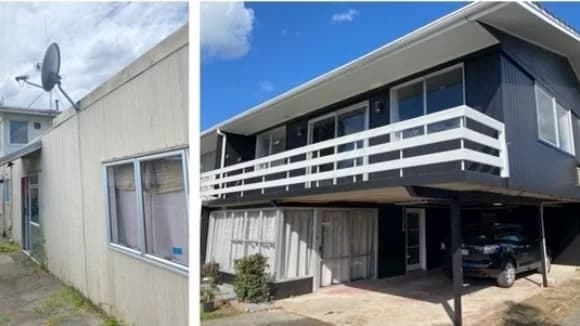
BRRRR
The ultimate guide to the BRRRR strategy
The BRRRR strategy is game plan for how to quite literally, build equity and value into a property through renovation improvement.
BRRRR
5 min read
Author: Ilse Wolfe
Former Renovations Coach at Opes Accelerate. Property Investor for 15 years.
Reviewed by: Laine Moger
Journalist and Property Educator, holds a Bachelor of Communication (Honours) from Massey University.
Door knobs and light switches may not sound like the blockbusters of property renovation.
But collectively they can redefine the whole perception (and price) of a property.
Usually, replacing these items is cheap, but can quickly add a lot of value and rental potential.
That’s why replacing the fixtures and fittings are step #4 of the Cashflow Hacking process – a clear approach to turbocharge any BRRRR project.
In this article you will learn the 4 things you need to do when upgrading the fixtures and fittings of your investment property.
Before we get into the process, it’s important to explain what fixtures and fittings are.
As a general rule:
The #1 way to make an old house feel new is to replace the ceiling lights. Replacing old hanging lights with downlights brings most homes into the 21st century.

Integrated LED ceiling lights offer the best solution. But there is a catch – they are a more expensive option.
As a rule of thumb, you will need 2 to 4 downlights a piece for a large living room and bedroom.
These will (more than likely) require an electrician to install as each light requires a pre-cut hole. Depending on the size of your property, this can take an electrician 2 days to complete. At $100 an hour, the price of labour can end up costing $1,000 – $3,000.
A cost-effective alternative is to use a ceiling-mounted oyster light, which is physically mounted under the ceiling. So, no cutting and more DIY-install friendly.
Better to be specific

Budget-wise, the actual lights cost the same. Usually, it’ll be $20-$50 per LED downlight, which is the same for one ceiling-mounted oyster. However, since oyster lights require less labour, there are cost savings here.
In the end, the choice you make may come down to what’s going for the property.
If you own a low-end rental, ceiling-mounted lights will have just as much impact as the more expensive option. So, in this instance it might not be worth the extra money to have integrated lights.
But if you're looking at the more premium side, you might want to consider the integrated lights that go up into the ceiling.
Yellowing light switches are a tell-tale sign that your property is old and hasn’t been maintained. They’ll quickly date your property, so they should be replaced.
But be careful when you do it, because a yellowing light switch may also mean it’s unsafe.
Why? Well, if your light switch (or power socket) is old enough to have lost its original colour, it is potentially hiding an outdated metal flush box behind the wall. Flush boxes can often get too hot.
That’s why a more modern flush box is made of plastic.
So when you update the front (exterior) of your light switch, be prepared to update the flush box too.
This will add labour cost as the fix requires an electrician’s expertise.

The next step is to replace the door knobs around the house.
It may sound hard to believe, but if you choose to install all the door handles in your property yourself, you will shave a lot of money from your overall budget.
An investor we’ve worked with saved $1500 on a labour quote by doing the install himself.
Door knobs are a super cheap accessory when you’re bargain bin hunting (or browsing AliExpress), but they can set you back quite considerably in labour.
As always, our rule is to “keep the future tenant in mind” – and this is true even of door knobs.
For instance, if the house is going to be rented by a family try to avoid d-ring handles on the doors. They can be all too tempting for a young child to swing on and break.

Existing kitchen cabinets will either have 1 or 2 screws for their handles.
In any renovation switch out, you’re probably going to want to exchange like for like. Or, said another way, you want to keep the same amount of holes in your cabinets.
Kitchen cabinets are coated (for splatter and durability) so you will need to strip that back and reapply if you want to mask any obvious holes left by a 2 to 1, or 1 to 2 switch.
You will either have a visible, leftover hole, or the placement may be unnatural when you try incorporating the existing 1-hole into a new 2-holed handle.
So, pay close attention to your cabinets before you go planning (or buying) new handles.
Yes, all these finer details can seem like a bit of a fiddle, but they are the thread that ties the bow on all your previous principals (e.g. adding a bedroom, bathroom renovation etc).
These fixtures and fittings have the collective power to haul your property out of its era and up to New Build status.
This is why it is really important to create a well-thought-out design for your interior.
For instance, pick 1 metal and make that uniform throughout the property, but always do your research on any idea you might have.
For instance, avoid trends and opt for genuine materials rather than base it purely on cost.
This is because if a replacement is needed X-years down the line, you will be able to find an easy replacement.
Otherwise you’ll have to decide between re-doing all the fixtures and fittings in the house or settling for a patchwork of different metals.
Remember, it’s always a fine balance between cost, materials, and the overall future of your property’s potential.